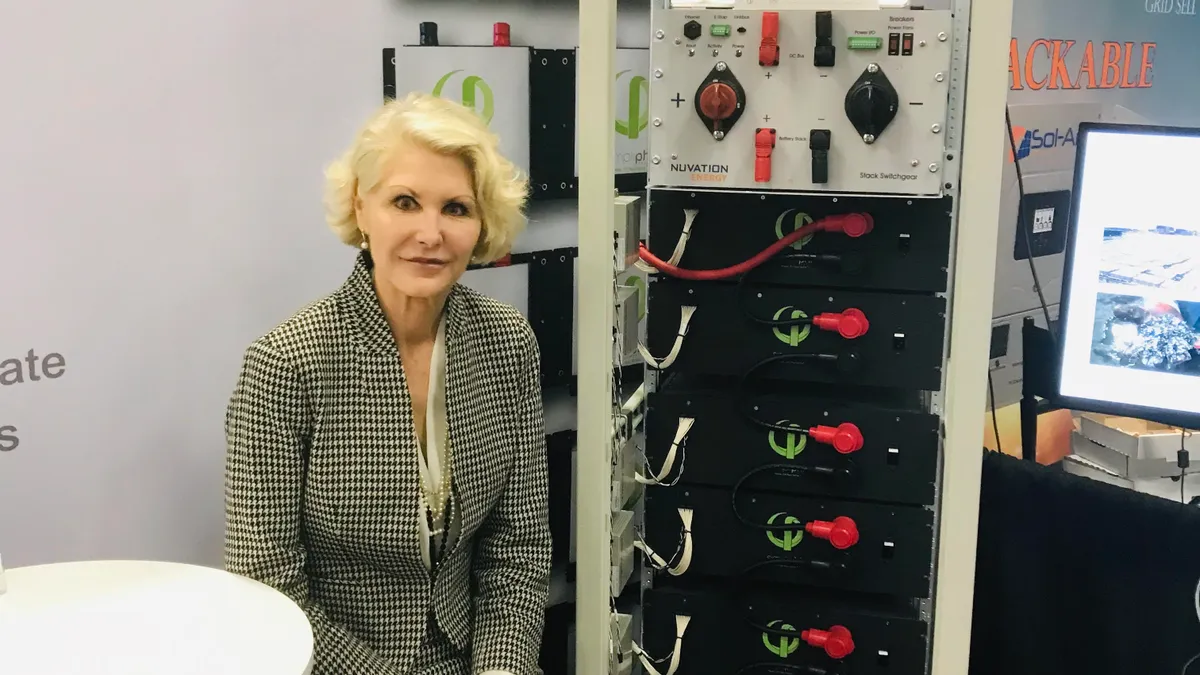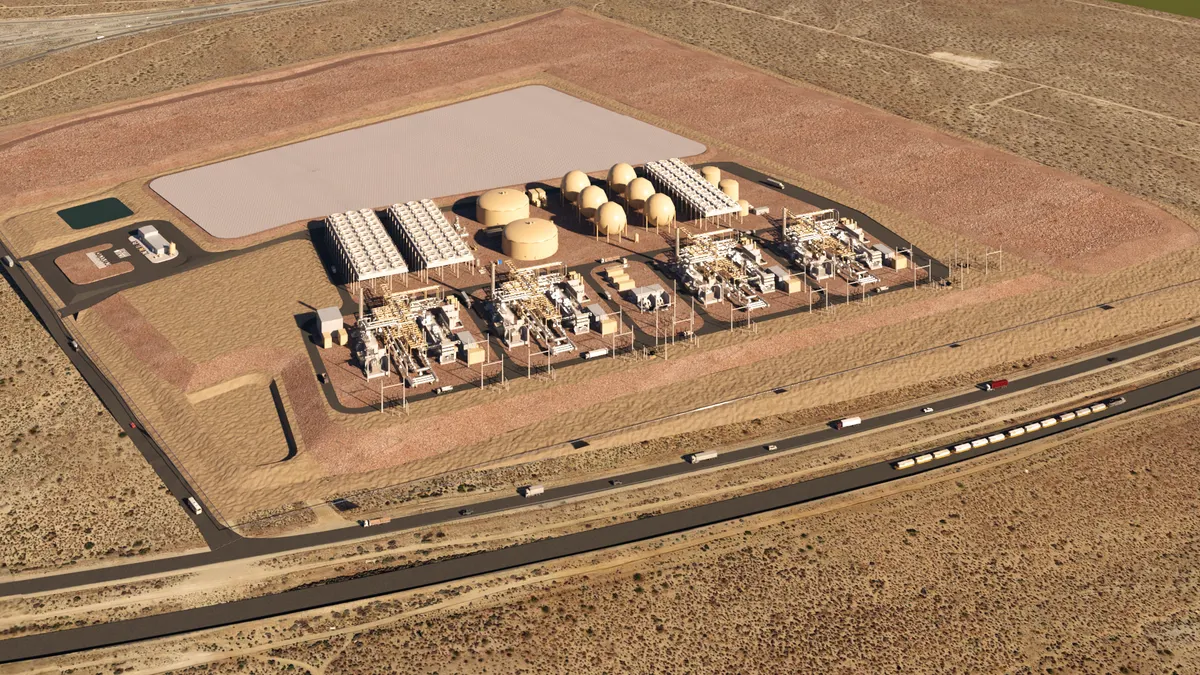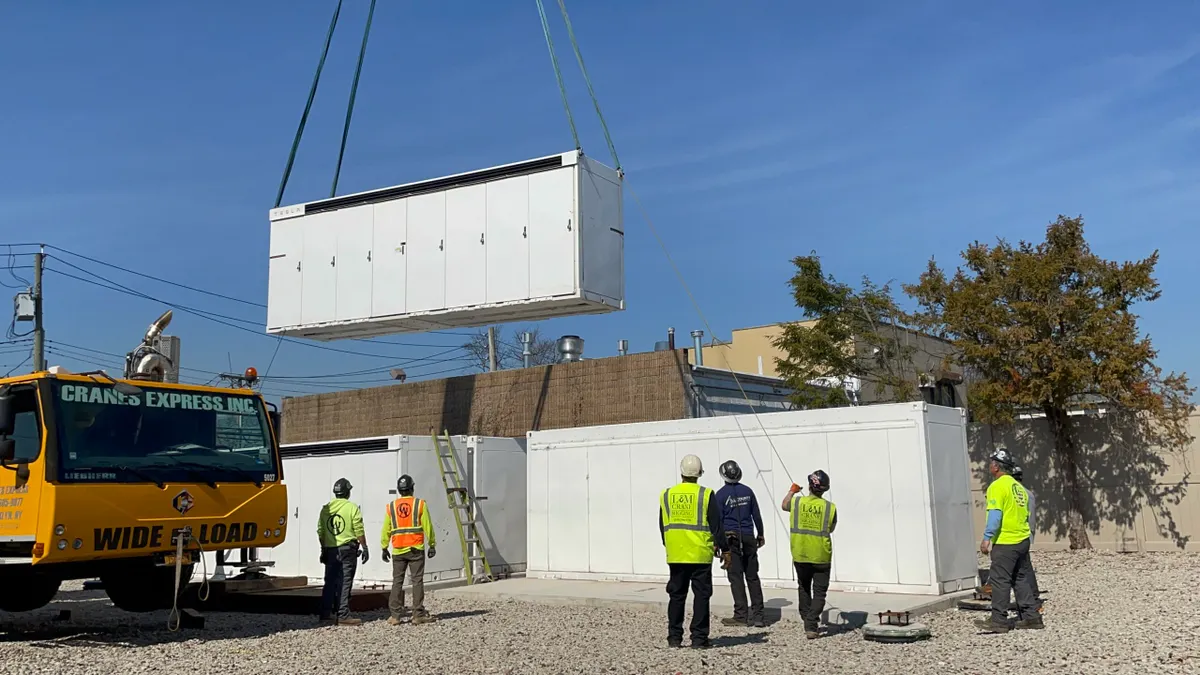SimpliPhi CEO Catherine Von Burg wants energy for everyone.
But first she wants to displace cobalt-based lithium-ion as the primary storage chemistry in the U.S. and elsewhere.
One of the most significant reasons that cobalt is still being used, despite its toxicity and safety-related concerns, is entrenched supply chains and companies, along with its cost advantage, she told Utility Dive in an interview Wednesday at Distributech in San Antonio.
"Now we're constantly closing the gap between our price per kilowatt hour and the prices for" both lithium nickel manganese cobalt oxide (NMC) and lithium nickel cobalt aluminum oxide (NCA) batteries.
But even with a cost advantage for cobalt-based lithium batteries, "what price is worth the risk of fire explosion? What price can you put [on that] when you're building your financial models? How do you factor in that risk?" she asked.
SimpliPhi has been pursuing its vision of universal access to affordable, safe and efficient energy for about 10 years now.
But its origins date back another nine years or so to Hollywood.
Von Burg founded SimpliPhi in 2010 with Stuart Lennox, now the company's chief technology officer, who began developing mobile portable batteries for the movie industry.
The model developed by Lennox for the movie industry — displacing large lead acid batteries and diesel generators, "because you can't shoot on a set with diesel noise and pollution and everything else" — became a model the company developed for the military, Von Burg said.
A boost from the military
The military "gave us a challenge and an opportunity ... [surrounding] access to energy for forward operating bases," she said, noting that when the military came to SimpliPhi, it had banned lithium-ion chemistry, but then found out about the lithium ferro phosphate (LFP) chemistry SimpliPhi was using.
The Department of Defense helped SimpliPhi prove out the safety of LFP, ultimately deploying the batteries in forward operating bases in Afghanistan and Iraq.
"We were able to create these mobile portable systems that men and women could carry with them on missions. With generators, they had a bullseye, they had the noise, they had the heat footprint, and they had the fumes constantly being generated. So we were able to help remove the bullseye" and significantly reduce the number of fuel convoys, Von Burg said.
"When we founded the company, my vision was to begin to scale up those mobile portable systems into residential and commercial and really address issues around the globe concerning access to energy, really changing the way people related to energy [so] they could become their own power plants, generate with folding solar panels and mini wind turbines, or optimize even their diesel generators," she said.
But getting SimpliPhi's message across can be challenging.
A failure to differentiate
There are mounting concerns over the safety of traditional lithium-ion systems, spurred on by multiple examples of battery fires, but many people in the industry still don't differentiate amongst lithium-ion chemistries, Von Burg said, adding that cobalt is toxic and hazardous while lithium is not.
But while steps have been taken to reduce the risks posed by cobalt-based lithium-ion batteries, "why dedicate [research and development and intellectual property] to mitigating risks when there's an opportunity to use ... the lithium iron phosphate that does not have cobalt," she asked.
"We wanted to simplify the whole proposition and not require thermal monitoring, mitigation, liquid polymer cooling, and all the other toxic elements that can go into just cooling the [cobalt-based] batteries and then [having] even more expense at the point of installation of the batteries to maintain narrow, thermal ambient temperatures," she said.
SimpliPhi's systems also have risks, Von Burg acknowledged. "You have electrical current, you have high voltages. Anywhere you have live current, it's dangerous. But on a fundamental level, for us, the chemistry matters and not being toxic certainly matters as well."
Furthermore, LFP has longer cycle life, deeper depth of discharge, faster rate of charge and discharge than a typical cobalt-based lithium battery, Von Burg noted. But it hasn't been an easy path, she told Utility Dive. "We've had to go up against huge multinational companies and indeed another battery manufacturer in the U.S. that uses cobalt," she said.
In addition, lithium batteries, cobalt-based or not, aren't the only storage game in town these days.
But "when comparing lithium-ion to other energy storage technologies, you need to consider performance and commercial viability of the technologies," Von Burg wrote in response to a follow-up question after the conference.
Not all of these energy storage technologies can be used for a variety of applications. "For instance, flow batteries cannot be used in all energy storage applications, which limits the ability for value stacking. Lithium-ion is able to be used for both long duration storage and short duration applications such as frequency regulation."
And SimpliPhi has competitors within the LFP world itself, including BYD and sonnen. The latter doesn't design or manufacture its own batteries, but has developed a software platform and buys other manufacturers' batteries while competing in the grid-tied residential market.
Transforming lives
Von Burg's background is in biomedical engineering, not batteries. But she used to work in major university research hospitals "and so [focused on] the idea of innovation and creating new products, although biotech at the time, that could transform people's lives.
When she met Lennox and founded SimpliPhi, she took a look at the platform technology he developed and thought about how this platform, and energy storage specifically, could transform people's lives, including the billions of people marginalized due to no or intermittent access to power.
Now SimpliPhi sells its products across the U.S. and 43 other countries.
The company serves customers both behind and in front of the meter, and works with distributors globally. "But when we're working with utilities, like the projects we have with [American Electric Power subsidiary Southwestern Electric Power Company] in Louisiana or projects in Albuquerque, utilities will purchase directly from us as [will] large commercial real estate developers, commercial businesses," she said.
These utility projects involve companies "that are really interested in looking at how you bridge distributed resources to their benefit and their utility [transmission and distribution] ... and how do they benefit the customer," she said. In these cases, the utility owns the asset and it's going on a customer site and then being aggregated with software.
Von Burg pointed to a project announced last week with Pepco in Maryland. It consists of a 70.2 kW rooftop solar array combined with a 46 kW/56 kWh battery system and is meant as a resiliency hub for grid outages. "But every day the solar and the batteries are [also] offsetting utility rates," she noted.
A false choice
SimpliPhi works with multiple utilities and recognizes some of the tensions that exist in today's transforming energy world, but thinks they're unnecessary.
"This idea that there's a choice between top-down centralized or distributed [resources], whether it's storage or generation, that's a false choice," Von Burg said.
"We're finding more and more utilities are really buying into this idea that distributed assets benefit the utility and ... their ratepayers and working with software developers [so that] distributed assets can be aggregated and then become a large kind of virtual power plant where they have a resource to deploy, but then when there are power outages or they need to deaggregate for resilience for individual customers, [they can do so]," she said. "That's a model that we've been speaking to and kind of executing on in other parts of the world. So we're really excited that's coming about in the U.S."
SimpliPhi is based in California and in addressing the value of distributed resources, Von Burg pointed to public safety power shutoffs, a program started in 2019 to reduce fire risks from the state's electric power system.
"How safe is it to de-energize whole communities or thousands if not tens of thousands of people?" she asked. "When PG&E had the outages in 2019, it was estimated that within the first three weeks, about 2 billion [dollars] in losses were incurred because of those outages, so that's not a safe proposition for the individuals who are living in the dark. It's not a safe proposition for the state, and it's not a safe proposition for the utility."
Distributed assets create that resilience and keep the lights on, whether it's a hospital, a school, or a community, which is critical for utilities and their mandate to provide safe, reliable power, Von Burg told Utility Dive.
"So there's a reciprocal kind of relationship and the economics there [versus the cost of losing power] certainly benefit the utility and the end user," she said.
But she understands why sometimes utilities might have doubts about distributed assets. "They have a business model and they have all their shareholders and that business model has driven their approach to how they do business," she said.
"The fact is though, that the environment literally is changing ... [and] technology is changing too and is opening up whole new ways of dispatching, generating and storing power" and creating multiple opportunities that utilities are finally getting to see.
"But they have to build those into their business model. They have to make economic sense. And I think that's what's happening currently — the economics are penciling out. So there's a real tipping point and the utilities, certainly the ones that are most forward thinking, are seeing that," Von Burg said.
A partnered future
SimpliPhi is a privately-held company that so far has not needed to raise any venture capital. The company became profitable in 2012 going into 2013 and has seen significant revenue growth, according to Von Burg.
This year, the company is looking at where it can increase manufacturing capacity outside of California, both overseas and domestically.
With the kind of growth that SimpliPhi is projecting to meet demand, the company will be looking for partners this year in areas such as working capital and project development. These could include "some of the larger companies from gas and oil on down who are looking to become fully integrated," Von Burg said, adding that SimpliPhi has already been approached by several large multinationals.
But while it has big growth plans, there are a number of obstacles for SimpliPhi and other storage companies. Interconnection rules and requirements very often add a lot of extra work and lead times for installers, Von Burg said.
"Having policies that would streamline interconnection would certainly be helpful, especially in California," she said. There are commercial businesses that lost power in PG&E territory that have been waiting over a year to get PG&E to sign off on the interconnection.
"For us as a company, what would really help is if regulators paid attention to the [idea that] chemistry matters in terms of safety.
As for the biggest threat to SimpliPhi, and what keeps her up at night from a business perspective, "something happening in the market that we're not seeing," Von Burg said.
"People ask us, what about when lithium ferro phosphate is surpassed or ithium-ion generally ... [But] we've always been ... chemistry agnostic."
SimpliPhi's intellectual property, she explained, is in the internal architecture and power electronics and how it fabricates that battery and the other batteries in a system. "So we're always looking at different chemistries and are ... not living in trepidation of a new chemistry because our IP and our platform will allow us to integrate newer chemistries and newer innovations," she said.
"When a similarly safe storage technology is available that is more cost effective, efficient, durable, et cetera, we will happily embrace it. We use LFP now because we believe it is currently the best choice."






















